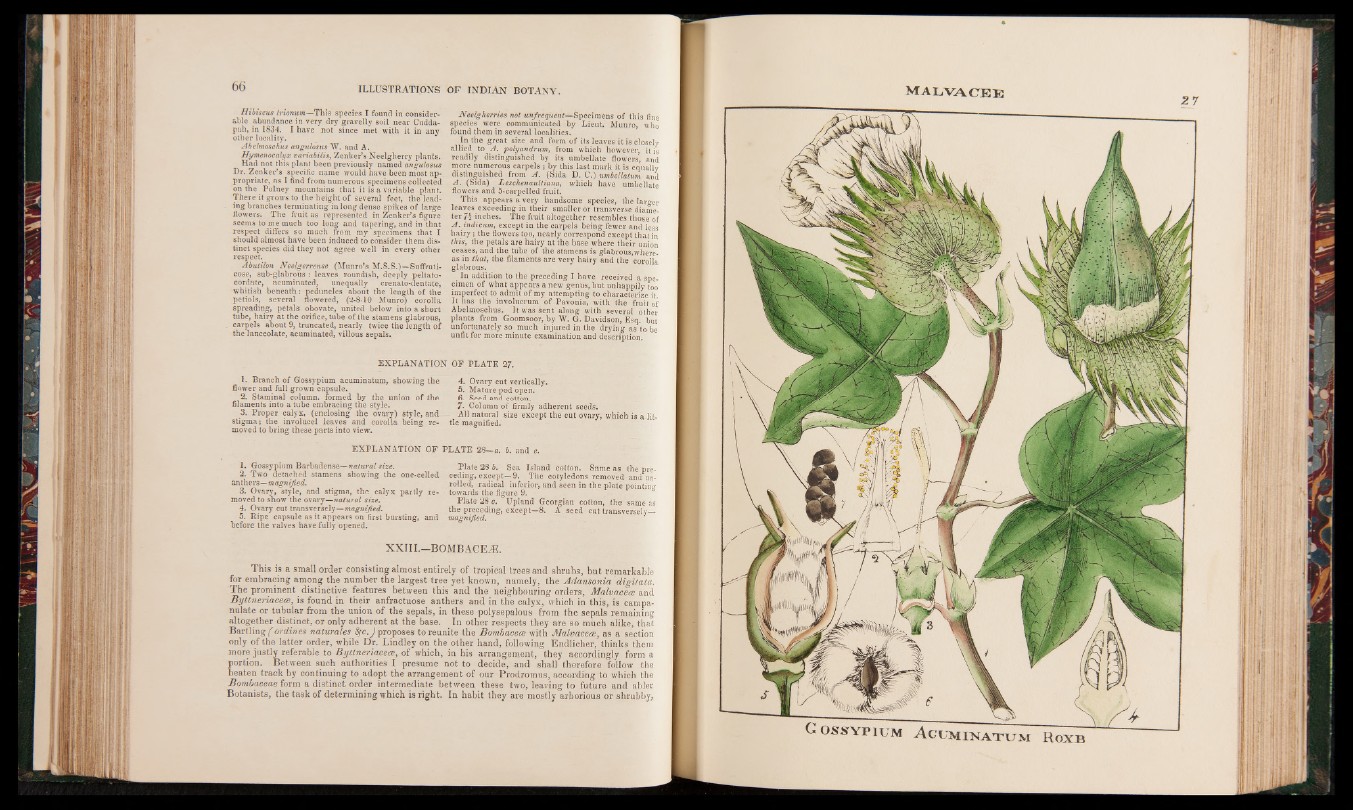
Hibiscus Irionum—This species I found in considerable
abundance in very dry gravelly soil near Cudda-
pah, in 1834. I have not since met with it in any
other locality.
Abebnoschus angulosus W. and A.
Hymenocalyx variabilis, Zenker’s Neelgherry plants.
Had not this plant been previously named angulosus
Dr. Zenker’s specific name would have been most appropriate,
as I find from numerous specimens collected
on the Pulney mountains that it is a variable plant.
There it grows to the height of several feet, the leading
branches terminating in long dense spikes of large
flowers. The fruit as represented in Zenker’s figure
seems to me much too long and tapering, and in that
respect differs so much from my specimens that I
should almost have been induced to consider them distinct
species did they not agree well in every other
respect.
Abittilon Neelgerren.se (Munro’s M.S.S.)—Suffruti-
cose, sub-glabrous : leaves roundish, deeply peltato-
cordate, acuminated, unequally crenato-dentàte,
whitish beneath: peduncles about the length of the
petiols, several flowered, (2-8-10 Munro) corolla
spreading, petals obovate, united below into a short
tube, hairy at the orifice, tube of the stamens glabrous,
carpels about 9, truncated, nearly twice the length of
the lanceolate, acuminated, villous sepals.
Neelgherries not unfrequent—Specimens of this fine
species were communicated by Lieut. Munro, who
found them in several localities.
In the great size and form of its leaves it is closely
allied to A. polyandrum, from which however, it is
readily distinguished by its umbellate flowers, and
more numerous carpels ; by this last mark it is equally
distinguished from A . (Sida D. C.) umbellatum and
A. (Sida) Leschenaultiana, which have umbellate
flowers and 5-carpelled fruit.
This appears a very handsome species, the larger
leaves exceeding in their smaller or transverse diameter
7k inches. The fruit altogether resembles those of
A . indicum, except in the carpels being fewer and less
h airy; the flowers too, nearly correspond except that in
this, the petals are hairy at the base where their union
ceases, and the tube of the stamens is glabrous,whereas
in that, the filaments are very hairy and the Corolla
glabrous.
_ In addition to the preceding I have received a specimen
of what appears a new genus, but unhappily too
imperfect to admit of my attempting to characterize it.
It has the involncrum of Pavonia, with the fruit of
Abelmoschus. It was sent along with several other
plants from Goomsoor, by W. G. Davidson, Esq. but
unfortunately so much injured in the drying as to be
unfit for more minute examination and description.
EXPLANATION OF PLATE 27.
1. Branch of Gossypium acuminatum, showing the
flower and full grown capsule.
2. Staminal column, formed by the union o f the
filaments into a tube embracing the style.
3. Proper calyx, (enclosing the ovary) style, and
stigma; the involucel leaves and corolla being removed
to bring these parts into view.
4. Ovary cut vertically.
5. Mature pod open.
6. Seed and cotton.
7. Column of firmly adherent seeds.
All natural size except the cut ovary, which is a little
magnified.
EXPLANATION OF PLATE 28—a. b. and c.
1. Gossypium Barbadense— natural size.
2. Two detached stamens showing the one-eelled-
anthers—magnified.
3. Ovary, style, and stigma, the calyx partly removed
to show the ovary—natural size.
4. Ovary cut transversely—magnified.
5. Ripe capsule as it appears on first bursting, and
before the valves have fully opened.
Plate 28 b. Sea Island cotton. Same as the preceding,
except—- 9. The cotyledons removed and unrolled,
radical inferior, and seen in the plate pointing
towards the figure 9.
Plate 28 c. Upland Georgian cotton, the same as
the preceding, except—8. A seed cut transversely—
magnified.
XXIII.—BOMBACEÆ.
This is a small order consisting almost entirely of tropical trees and shrubs, but remarkable
for embracing among the number the largest tree yet known, namely, the Adansonia digital«.
The prominent distinctive features between this and the neighbouring orders, Malvaceae and
ByttneriacetB, is found in their anfractuose anthers and in the calyx, which in this, is campa-
nulate or tubular from the union of the sepals, in these polysepalous from the sepals remaining
altogether distinct, or only adherent at the base. In other respects they are so much alike, that
Bartlingf ordines naturales fyc.J proposes to reunite the Bombacece with Malvaceae, as a section
only of the latter order, while Dr. Lindley on the other hand, following Endlicher, thinks them
more justly referable to Byttneriaceae, of which, in his arrangement, they accordingly form a
portion. Between such authorities I presume not to decide, and shall therefore follow the
beaten track by continuing to adopt the arrangement of our Prodromus, according to which the
Bombaceae form a distinct order intermediate between these two, leaving to future and abler
Botanists, the task of determining which is right. In habit they are mostly arborious or shrubby,
G o s sy p ium A c um in a t um Roxb